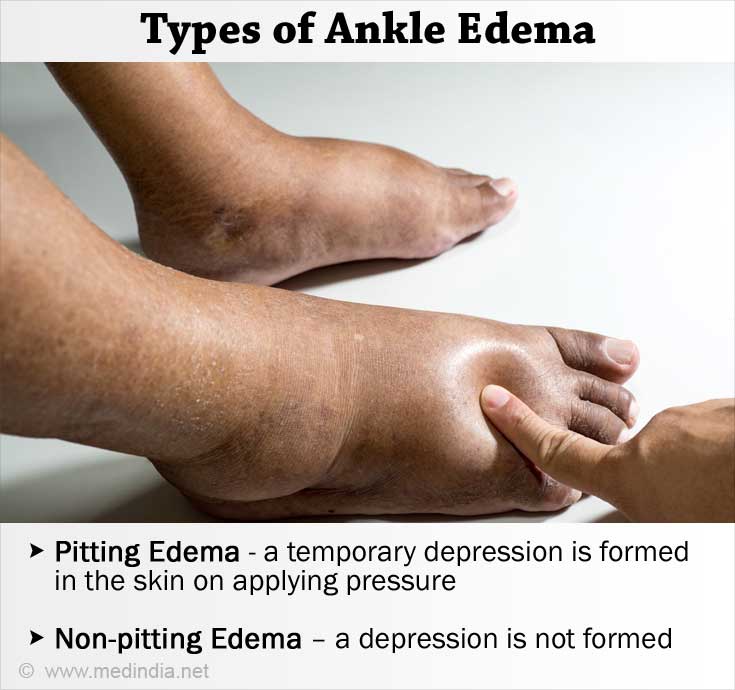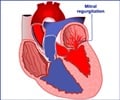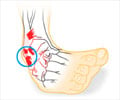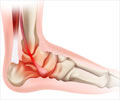- PJ Mehta’s Practical Medicine
- Current Medical Diagnosis and Treatment 2012
About
Ankle edema is a swelling over either one or both ankles.
Swelling of the ankles is quite common, especially if you have been travelling for a long duration. It occurs due to accumulation of excessive fluid in the tissues of the ankle and feet, a condition referred to as ankle edema. As the amount of fluid accumulates, the swelling may rise up into the leg.
Due to man’s erect posture, the blood in the veins of the leg has to move against gravity towards the heart. This unidirectional flow of blood is ensured by the presence of valves in the veins and the contractions of the leg muscles. Thus, any problem with the return of blood to the heart can increase the blood pressure in the veins, resulting in seepage of fluid into the tissues, and ankle edema.
Ankle edema may be described as pitting or non-pitting. If a temporary depression is formed in the skin on applying pressure, the edema is referred to as pitting edema. On the other hand, if the depression is not formed, the edema is known as non-pitting edema. Edema is usually of the pitting type. Non-pitting edema may be observed in conditions like hypothyroidism, where there is some thickening of the tissues.
Many cases of ankle edema subside with simple leg elevation; the legs should be elevated above the level of the heart 3 to 4 times a day and during sleep. Compression stockings may be useful in cases that occur due to reduced venous return of blood to the heart. In other conditions, the underlying cause has to be treated.
Ankle edema or swelling may be localized to one side or may be present in both the ankles. A single ankle swelling is likely to be due to a local cause, whereas swelling in both the ankles is likely to be due to something that affects the entire body system.

Cause of Ankle Edema / Ankle Swelling in Both Legs
Ankle edema in both legs may be due to one of the following conditions:
- Cardiac disease: A decrease in the pumping function of the heart results in excessive pressure in small blood vessels, resulting in leakage of fluid into tissues. This fluid accumulates at the ankles due to gravity. Heart failure is a common cause of ankle edema. The swelling is more prominent in the evening after a hard day’s work. In patients who cannot move around and spend most of their time lying down, the fluid accumulates in the lower back. Another heart condition that can result in ankle edema is pericardial effusion. In this condition, fluid accumulates in the space just outside the heart and prevents proper function of the heart.
- Kidney disease: Conditions affecting the kidneys result in accumulation of excessive fluid in the body and loss of protein in the urine, which contributes to the development of edema. Edema due to kidney disease is more commonly seen in the morning. Swelling is observed all over the body especially the face.
- Liver disease: Liver disease can cause ankle edema consequent to a reduction in blood protein levels and compression of some of the liver blood vessels. The patient usually has fluid accumulation in the abdomen as well.
- Problem with the veins: Obstruction of blood flow in the inferior vena cava, the main vein that carries blood from the lower part of the body to the heart, results in accumulation of blood in the legs and edema. The veins in the flanks are usually prominent.
- Hypothyroidism: Very low levels of thyroid hormone can cause a puffy appearance of the face, hands and feet. The patient may also complain of lethargy, weight gain, constipation, hoarseness of voice, and a dry and rough skin among other symptoms.
- Allergic reaction: Severe allergic reactions are associated with swelling of the tissues just below the skin; this condition is called angioneurotic edema. The swelling is present all over the body and is not restricted to the ankles. The person shows the presence of a rash and may be breathless if the reaction is severe.
- Anemia: Anemia, or a low red blood cell count, is associated with edema in some cases. The patient also appears very pale.
- Medications: Medications like calcium channel blockers especially felodipine and amlodipine are known to cause ankle edema. Other drugs that are associated with ankle edema include minoxidil and the antidiabetes drugs belonging to the thioglitazone group like pioglitazone and rosiglitazone.

Cause of Ankle Edema / Ankle Swelling in One Leg
Conditions that result in leg edema only on one side are:
- Conditions that obstruct the flow of lymph: Like blood, lymph is a fluid that is carried by vessels called lymphatic vessels, which ultimately joins the blood. Obstruction of flow of lymph from the leg can result in a backlog, thereby resulting in edema. Lymphatic obstruction in the leg may occur due to filariasis, pressure on the lymphatic blood vessels by a growth that could be cancerous, or radiation.
- Fracture or sprain: A fracture or a sprain of the ligaments at the ankle results in swelling, pain and difficulty with movement of the ankle.
- Cellulitis: Infection of the tissues under the skin called cellulitis results in swelling, redness and tight skin over the leg.
- Gout: Gout usually results in swelling of the first toe. In some cases, the swelling may be present in the ankle.
- Venous thrombosis: Clots are sometimes formed in the deep veins due to stagnation of blood. This could be due to lack of adequate movement of the limb if the patient is bedridden following paralysis or surgery. These clots block the blood flow from the limb to the heart and can cause swelling. There is tenderness present along the affected vein.
- Varicose veins: Dilatation of leg veins results in varicose veins. The veins cannot perform their function of returning blood to the heart well, thus resulting in edema. The skin over the ankles may appear thickened and itchy. An ulcer may form in some cases.
- Milroy disease: Milroy disease is a genetic condition due to a problem with the lymphatic drainage of a leg. The patient, usually a child, experiences swelling on one leg.
Frequently Asked Questions (FAQs)
1. Which doctor should I visit in case I suffer from ankle edema?
You should visit your general practitioner or family doctor, who will guide you to the right specialist.
2. How is ankle edema treated?
Ankle edema often resolves by keeping the legs raised for some time. When it is due to some specific cause, treating the cause will result in resolution of the swelling. Compression stockings may be useful in some conditions like varicose veins. Maintain a healthy diet, drink adequate water and it is best to avoid pickles and canned foods to reduce water retention in feet.














